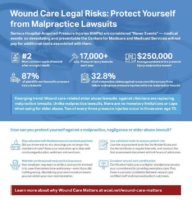Dedicated wound care professionals pride themselves on providing optimum care for their patients.
Did you know you also have an ethical and legal obligation to provide the best care possible or you face legal risk?
You could be held liable whether you are an experienced or new wound care clinician, certified or not certified, or work in acute care, long-term care or the ambulatory environment.
Providing substandard wound care not only harms patients, it also can result in a patient or their family taking legal action against you and other clinicians involved in the patient’s care plan, said Nancy Brent, JD, MS, RN, a nurse attorney who represents nurses before the state regulatory agency and has a solo law practice in Wilmette, Ill.
And no one wants to face professional negligence or malpractice allegations.
“The legal fallout from litigation pertaining to patient care can range from being sued for medical malpractice or professional negligence, in addition to the fees related to legal representation and damages owed if you’re held legally responsible,” she said.
“You’ll also be reported to your state regulatory agency that oversees your license, whether you’ve been legally cleared or not,” Brent continued. “State regulatory boards will investigate cases to determine if you violated your state and professional practice act. You could lose your license if found in violation of your practice act, even if the patient did not incur an injury.”
There is another possible legal outcome for clinicians treating the elderly that has recently come to light.
“One trend we’re seeing now is if the patient is an elder, some clinicians are not being sued for malpractice, they are now being sued for elder abuse,” said Melanie L. Balestra, NP, Esq., who practices healthcare law in Irvine and Newport Beach, Calif., in the Law Offices of Melanie Balestra.
“The reason is there are monetary limitations, known as caps, regarding damages with malpractice cases,” she continued. “However, there are no monetary limitations or caps with cases pertaining to elder abuse.”
Balestra said in addition to charges of elder abuse, wound care is an area with a large increase in malpractice cases. Some of the high-risk areas usually examined in wound care-related cases include:
- Treatment and care: Patient did not receive the appropriate treatment or care
- Communication failures: Clinician to patient and family, or clinician to clinician
- Medication administration: Failures in administering medication
- Informed consent: Not obtained, and/or not charted
- Documentation: Errors and omissions
Diffuse legal risk by staying current on evidence-based treatments
Getting certified in wound care is one way to gain knowledge and skills to continue gaining competency in providing good wound care, Brent said.
“Even if certified, it’s extremely important to keep up with the latest standard of practice by reading journals, taking relevant continuing education courses, and recertifying when required,” she said. “Once certified, you will be held to a higher standard of care. However, don’t be afraid to get certified, as it’s a badge of honor and shows a commitment to providing exemplary care.”
Balestra strongly recommends all clinicians maintain their own professional malpractice insurance to mitigate legal risk.
“Sometimes employers will want to settle a case you’re involved in to save themselves time and money – even if you did nothing wrong,” she said. “However, you may not want to settle. When you carry your own insurance, you can obtain your own attorney to represent you.”
Reducing your risk for liability by engaging in safe practice is important, said Linda Farmer, MSN, CNOR, RNFA, CWS, an acute care nurse practitioner with the Medical Arts Surgical Group/Anderson Wound Healing Center in Meridian, Miss., who has worked in wound care and surgery for 15 years.
“Remaining current on the latest wound care practices via continuing education, literature review, following and participating in research, and practicing excellent wound-care specific documentation is essential,” Farmer said.
“Wounds should be measured and progress recorded in an organized manner for the duration of the treatment and a plan of care delineated so you can know if the patient’s healing is progressing, and if it’s not, what’s next,” she continued. “If possible, periodic photographs should be taken after obtaining informed consent, of course.”
Statistics highlight the legal risk of substandard care
- From 2010 to 2014, one in nine cases of malpractice involved a medication issue.
- From 2009 to 2013, more than 7,100 malpractice cases involved communication failures.
- More than 2.5 million people in the U.S. develop pressure ulcers annually in acute care.
- In 2009, the presence of pressure ulcers in long-term care patients was 7.5% at a cost of more than $3.3 billion.
- Failure to diagnose accounted for 32.8% of all malpractice claims against nurse practitioners with one malpractice insurer.
Click to learn why Wound Care Matters today.
What do you think?



